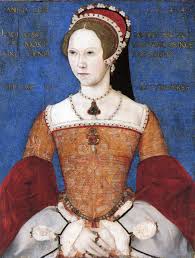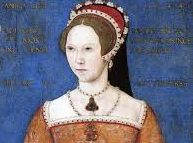
In June 1536, Mary had formally submitted to her father’s authority. She had assured the King in writing that she believed that her parents’ marriage was unlawful, that she herself was a bastard, and that the King was justly the supreme head of the English Church (Cromwell had sent her suggested language of what her submission should look like to escape charges of treason, she copied the draft verbatim). Henry and Jane had visited her over the summer, they had exchanged gifts, but Mary had not yet made her formal return to court, first because she was not well, then because of an outbreak of the plague. That ceremony would occur on December 17, just in time for the Christmas festivities.
The story is classic, and I can’t think of it without conjuring up Masterpiece Theater’s amazing version from some 40 years ago. Henry VIII (Keith Mitchell) and Jane Seymour (Anne Stallybrass) sitting in their chairs of estate at the far end of the presence chamber when Mary is announced. For PBS’ purposes this is the original reconciliation (Jane got one episode, they had to keep things simple…) and they maximize the drama. After Mary is formally announced, she curtsies deeply once at the door, a second time halfway through the crowded room, then a third time directly before the royal platform “Your blessing, Sire,” she breathes.
“Welcome, child,” Henry says as he raises her and kisses her forehead.
“Welcome, Mary,” echoes Jane.
Then comes the meat of the scene. Henry puts a hand on Mary’s shoulder and looks around the room threateningly before exclaiming, “Some of you wanted me to put this jewel to death.”
Jane jumps in to reassure Mary: “That were a great pity, to lose your chiefest jewel of England.”
(Here, Masterpiece Theater makes its second historical mistake: they skip Henry’s response, “Nay, nay. Edward, Edward” that he gives while patting Jane’s stomach – they go right into Mary fainting, whether from shock, fear, the heat, or all three.)
Either way, with this formality out of the way, Mary was often at court afterwards. She even persuaded the King and Queen to invite Elizabeth to court for the Christmas season. It is heartening that diplomats who saw Henry playing with his younger daughter noted the affection he showed for her…
***
If you like my posts, you’ll love my books! My Seymour Saga trilogy tells the gripping story of the short-lived dynasty that shaped the Tudor Era. Jane the Quene skews romantic, The Path to Somerset is pure Game of Thrones (without the dragons), and The Boy King is a noir coming-of-age. Get them now through Amazon, Barnes & Noble, Kobo, and Apple, or even your local independent bookstore!

(PS Already read them? Did you love them? Then please review them – even just a stars rating! It makes a huge difference in helping new readers find them and would mean the world to me!)

Can you source the assertion that Mary was responsible for the reconciliation between Henry and Elizabeth, every source I have seen gives credit to Jane for the reconciliation between Henry and his daughters.
I agree that Jane gets the lion’s share of credit for the reconciliation between Henry and Mary. But historians from Agnes Strickland to Elizabeth Norton have noted the minimal interest that Jane displayed toward Elizabeth (Elizabeth Norton in her biography of Jane writes “Elizabeth is known to have resembled Anne Boleyn facially and Anne had been a fond mother, both factors that may have caused Jane to keep her distance from the child”).
It has always made sense to me personally too. And i suspect that the protective instincts that Elizabeth inspired in Mart during this time may have lingered a tiny bit and helped to keep her safe in the early says of Mary’s reign (later on it is clear the glow was gone!)
Actually, the people who deserve the credit for Henry’s reconciliation with Mary, and for literally saving her life, are Thomas Cromwell and Eustace Chapuys. Without their direct intervention, only God (and Henry) knew if Mary Tudor would have survived the reign.
I agree – and not to toot my own horn, but I worked hard to show that in Jane the Quene!